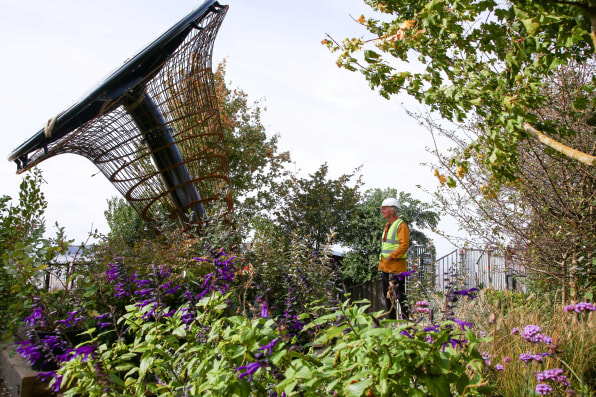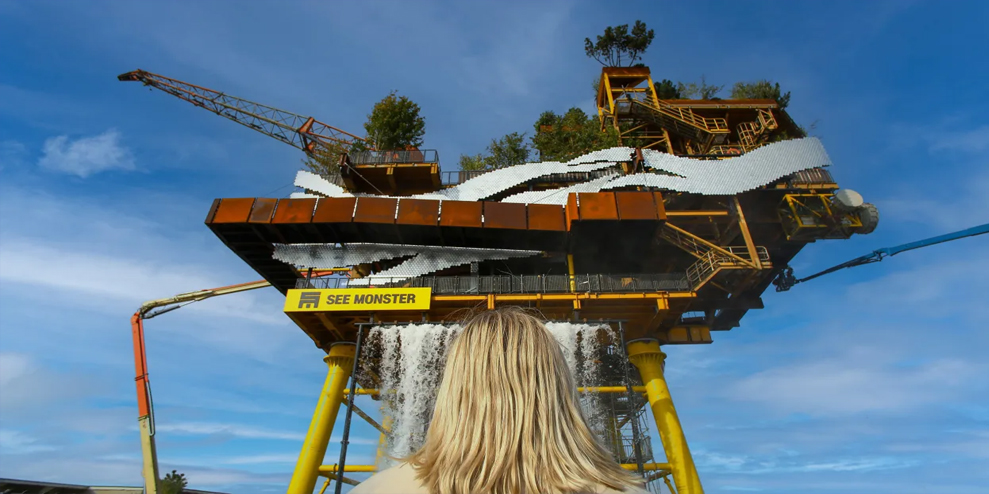Temporary installations like the U.K.’s ‘See Monster’ are a mixed bag of benefits and drawbacks.
This autumn, visitors to Weston-super-Mare on the west coast of England will be confronted by the strangest of sights: a repurposed oil rig, temporary art installation and high-rise garden, dubbed the See Monster.
Located in a shallow pool at the former Tropicana open-air swimming baths, once home to artist Banksy’s Dismaland, it is one of 10 major commissions that comprise Unboxed: Creativity in the U.K. A 120 million-pound (nearly $135 million) year-long program of free events and activities, Unboxed was conceived and funded by the U.K. government as a post-Brexit celebration with a mission to inspire conversations and future careers in science, technology, engineering, and mathematics.
See Monster is a huge, ambitious project. It is one of the U.K.’s biggest public art works and the first to reuse a structure synonymous with fossil fuels to raise awareness of the climate emergency, renewable energy, and sustainability.

But questions have been asked about the project’s impact and legacy. Particularly, critics have mentioned how the decision to tear it down after only six weeks of operation (on November 5) appears wasteful and counter to the environmental message—although this is necessary to avoid any impact on the wading birds that migrate to the area in the winter.
See Monster has also been caught up in criticism of the Unboxed festival itself, which has been branded “an irresponsible use of public money” at a time of great economic uncertainty and hardship.
Like London’s controversial Marble Arch Mound, an artificial hill designed to attract shoppers to Oxford Street, which came in over budget and was widely panned, See Monster calls into question the value of “pop-up” attractions in revitalizing our towns and cities, and of culture-led urban regeneration in general.
POP-UP TOURISM
At 35 meters tall (about 115 feet) and weighing 450 tons, See Monster is split over four levels with a waterfall that’s 10 meters (about 33 feet), cascading from the lowest level. It features small trees, plants, and grasses. There is a playground slide and animated sculptures, including some 6,000 “scales” attached to the exterior that move in the wind. There are also water atomizers to generate clouds and numerous vantage points offering unrivaled views of the resort and surrounding countryside. It attracts a range of visitors, from curious tourists to organized visits by school groups.
These “here today, gone tomorrow” visitor attractions are the extension of a trend that began in the 1990s with pop-up shops in empty units along high streets and in shopping centers and precincts. The “experience industries,” including tourism, have long been used as a tool of urban regeneration, with former factories, warehouses, harbors, and deep mines rebuilt into museums, bars and restaurants, hotels, and shopping malls.
Structures like See Monster take this one step further. Instead of a permanent change of use, they temporarily occupy, reuse, and adapt existing structures and infrastructure in towns and cities left redundant, or in danger of redundancy, by economic and financial crises and other triggers of change, such as the pandemic. These temporary installations are made for the Instagram age, generating countless selfies, positive comments, and “likes” on social media.
Examples of what we might call “pop-up tourism” include urban beaches, such as Paris Plage, Bavarian-style Christmas markets, linear parks on abandoned rail routes, and character arts trails like Gromit Unleashed in Bristol.

Research has shown that pop-ups can attract significant footfall, spending, and publicity for the host town or city. They can also help reimagine a rundown or underutilized site, as with the Tropicana, with a view to attracting private investment and a permanent change of use (such as Castlefield Viaduct park in Manchester). More altruistic possibilities include creating open space for communities for recreation, promoting behavioral changes (for example, taking up exercise or sustainable living), or raising money for good causes.
THE “CULT OF THE TEMPORARY”
Despite the reported benefits, geographers Ella Harris and Mel Nowicki question whether the pop-up phenomenon is good for cities. Temporary urbanism, they argue, promotes short-term fixes to complex and enduring urban problems. It also can create precarity (think zero-hour jobs and short-notice evictions).
These pop-ups are a distraction from the deeper problems of capitalism and the pathologies of urban life, such as air pollution and grinding poverty. In this, they tend to perpetuate inequalities rather than tackling their root causes.
A lot depends on the pop-up. Ambitious, expensive projects like the See Monster can struggle to live up to the hype and are vulnerable to the criticism that the money would have been better spent on schools and hospitals. Smaller, community-led schemes with modest ambitions, or serendipitous events like Dismaland that seem to come out of nowhere, are likely to be better received and to leave a positive legacy.
While pop-ups are themselves transitory in nature, the trend toward ephemera, simulation, and event-based tourism in urban areas is here to stay. That means the debate on whether they are good or bad for our towns and cities will carry on, long after See Monster has retreated from public view.
—
This article first appeared www.fastcompany.com
Seeking to build and grow your brand using the force of consumer insight, strategic foresight, creative disruption and technology prowess? Talk to us at +971 50 6254340 or engage@groupisd.com or visit www.groupisd.com/story




